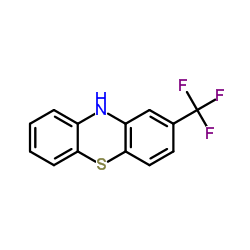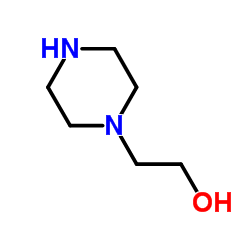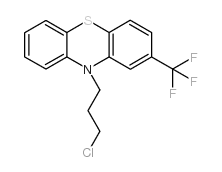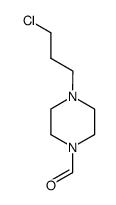69-23-8
| Name | fluphenazine |
|---|---|
| Synonyms |
1-Piperazineethanol, 4-(3-(2-(trifluoromethyl)-10H-phenothiazin-10-yl)propyl)-
2-{4-[3-(2-trifluoromethyl-phenothiazin-10-yl)-propyl]-piperazin-1-yl}-ethanol hiazine dapotum 4-(3-(2-(trifluoromethyl)phenothiazin-10-yl)propyl)-1-Piperazineethanol Sevinol Elinol Pacinol 10-[3'-[4''-(b-Hydroxyethyl)-1''-piperazinyl]propyl]-3-trifluoromethylphenothiazine 2-(Trifluoromethyl)-10-[3-[1-(b-hydroxyethyl)-4-piperazinyl]propyl]phenothiazine 4-[3-[2-(Trifluoromethyl)-10H-phenothiazin-10-yl]propyl]-1-piperazineethanol 4-[3-[2-(trifluoromethyl)phenothiazine-10-yl]propyl]-1-piperazineethanol S 94 2-(4-(3-(2-(Trifluoromethyl)-10H-phenothiazin-10-yl)propyl)piperazin-1-yl)ethanol Fluphenazine 2-(4-{3-[2-(Trifluoromethyl)-10H-phenothiazin-10-yl]propyl}-1-piperazinyl)ethanol 1-Piperazineethanol, 4-[3-[2-(trifluoromethyl)-10H-phenothiazin-10-yl]propyl]- 2-(4-{3-[2-(trifluoromethyl)-10H-phenothiazin-10-yl]propyl}piperazin-1-yl)ethanol 1-(2-Hydroxyethyl)-4-[3-(trifluoromethyl-10-phenothiazinyl)propyl]piperazine |
| Description | Fluphenazine is a potent, orally active phenothiazine-based dopamine receptor antagonist. Fluphenazine is used for the research of schizophrenia. Fluphenazine blocks neuronal voltage-gated sodium channels[1]. |
|---|---|
| Related Catalog | |
| References |
| Density | 1.3±0.1 g/cm3 |
|---|---|
| Boiling Point | 568.3±50.0 °C at 760 mmHg |
| Melting Point | 268-274℃ |
| Molecular Formula | C22H26F3N3OS |
| Molecular Weight | 437.522 |
| Flash Point | 297.5±30.1 °C |
| Exact Mass | 437.174866 |
| PSA | 55.25000 |
| LogP | 4.84 |
| Vapour Pressure | 0.0±1.6 mmHg at 25°C |
| Index of Refraction | 1.579 |
CHEMICAL IDENTIFICATION
HEALTH HAZARD DATAACUTE TOXICITY DATA
|
| Symbol |



GHS02, GHS06, GHS08 |
|---|---|
| Signal Word | Danger |
| Hazard Statements | H225-H301 + H311 + H331-H370 |
| Precautionary Statements | P210-P260-P280-P301 + P310-P311 |
| Hazard Codes | F,T |
| Risk Phrases | 11-23/24/25-39/23/24/25 |
| Safety Phrases | 16-36/37-45 |
| RIDADR | UN1230 - class 3 - PG 2 - Methanol, solution |
|
~% 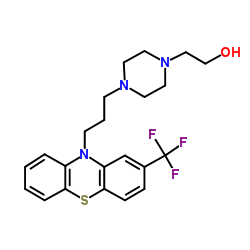
69-23-8 |
| Literature: Journal of Pharmaceutical Sciences, , vol. 67, # 2 p. 157 - 162 |
|
~% 
69-23-8 |
| Literature: Journal of Pharmaceutical Sciences, , vol. 67, # 2 p. 157 - 162 |
|
~% 
69-23-8 |
| Literature: Arzneimittel Forschung, , vol. 12, p. 937 - 942 |
|
~% 
69-23-8 |
| Literature: Arzneimittel Forschung, , vol. 12, p. 937 - 942 |
